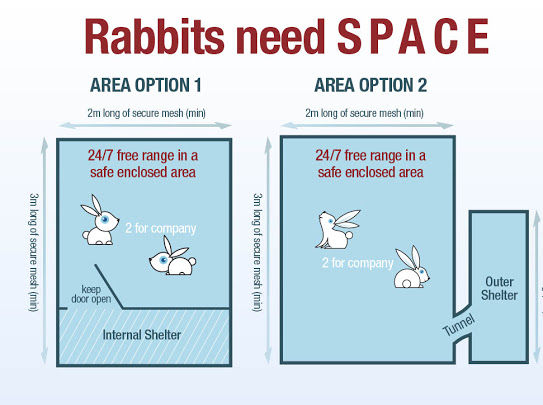A Better Life For Rabbits
- OVFAUK Guest Blogger
- Apr 30, 2021
- 4 min read
Updated: Jan 4, 2023
One Voice for Animals UK Guest Blog by Lea Facey
Lea is passionate about rabbit welfare and is currently studying a rabbit behaviour course and runs a two Rabbit Rescues, The Rabbit Residence and Hope for Hoppers, in Hertfordshire.

Picture 1 shows the welfare guidance on space that is needed to keep your rabbits safe and healthy
There are many ways in which rabbit welfare in the UK could be improved, from pet shops no longer selling rabbits to education on diet and the need to live with another neutered rabbit.
For me without a doubt the cruel practice of keeping rabbits in hutches and cages comes top of the list. In the wild, rabbits run the equivalent of 30 football pitches per day and live communally in a complex maze of underground tunnels known as a warren. They graze on an area of between 0.3 and 0.7 hectares.
The length of an average sized domestic rabbits hop is just over 60cm. They would be around 75cm tall when standing on their hind legs and will be a similar length when laying stretched out. Yet hutches and cages between 100cm and 182cm are being sold as a suitable home for a rabbit!
Pictures 2 and 3 show the inadequate sized hutches that rabbit owners are buying from pet stores for their pets. Sometimes more than one animal is living in these.
In a smaller hutch or cage, such as those above, an average sized rabbit would not even be able to lie fully outstretched in any direction, stand up on their hind legs without their ears touching the roof and in smaller hutches or cages many rabbits could not even turn around unimpeded. Even in a larger 6ft hutch the rabbit would only be able to take 3 hops in one direction. Yet, many rabbits live their entire lives imprisoned and alone in a hutch or cage with nothing to do. This is the equivalent of us living in a small bathroom.
Hutches are generally badly designed with a small sleeping area and an area with a mesh door. This means a rabbit is often left to suffer as they are exposed to the heat, wind and rain. Leaving them little option but to sit in damp bedding or the tiny bedroom area where they usually go to the toilet.
The Animal Welfare Act of 2006 sets out 5 basic welfare needs, including the need to live in a suitable environment and to be able to exhibit natural behaviours. Natural behaviours in rabbits include running, standing on their hind legs (periscoping), jumping (binkying), grazing, digging, hiding and socialising with other rabbits. Almost all of these behaviours are impossible even in the largest hutch or cage, yet the sale of hutches and cages in pet stores and by general online retailers is still widespread due to both lack of owner knowledge and a disregard to animal welfare by so many companies who put profits before pets.
As a volunteer and manager of one of the largest rabbit specific rescues in the UK, I see first hand on a daily basis the long term physical and psychological damage done to rabbits by ill-informed owners who have kept rabbits confined to tiny hutches or cages.
Spine and limb deformities, muscle wastage, stasis, bladder and respiratory issues can all be a result of keeping rabbits in tiny hutches or cages. Many times the psychological damage exceeds the physical issues caused by housing rabbits inappropriately. Stereotypical behaviours such as bar biting and wood chewing due to boredom and frustration are commonplace. Other behaviours such as self harming due to high stress levels at being confined are also regularly seen.
Furthermore, fear aggression is common due to rabbits feeling trapped inside a small space, unable to get away from things that scare them. Being a prey species this often includes human hands. Sadly, fear aggression is one of the main reasons rabbits end up being signed over to rescues.
Research conducted by the RSPCA, PDSA and the Rabbit Welfare Association has concluded that the minimum sized enclosure a rabbit should be housed in is 3mx2m and should be at least 1m tall. This, along with suitable enrichment, a hay or grass based diet and a neutered rabbit companion allows rabbits to exhibit the full range of natural behaviours which lowers the chance of health issues by giving the rabbits sufficient room to exercise.
All of the images below show the setups that would be ideal for rabbits. Image one below shows the size difference between one of the small hutches from above and the size of an enclosure that is actually suitable for rabbits.
Quite simply a hutch (or cage) is never enough!
What can you do to help?
Sign the petitions on the OVFAUK campaign page, use the templates to write complaints to retailers and MPs and support the Rabbit Welfare Association campaign ‘A Hutch is Not Enough’.
If you would like to Support either of the rabbit rescues Lea is involved in, you can do so here - The Rabbit Residence and Hope for Hoppers
One Voice for Animals UK has a rescue directory of almost 300 organisations that need support. If you enjoyed this blog, head over and find your local rescue and make a donation
























Your blog really drives home just how much space bunnies need to be 'normal'. I love the accommodation examples!